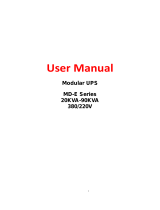4
1 Product Overview
1.1 Information & Features
TPower series is designed as a pure sine wave inverter, which converts 110/220VDC to220/230VAC.
This device consists of a DC-AC inverting module and an AC-AC bypass module in parallel. It also
features high reliability, high efficiency, concise appearance, full protection, easy installation, and
operation functions.
DC-AC inverting module is an intelligent and fully digitally designed component with advanced SPWM
technology. The module is designed with the pure sine wave output to convert 110/220VDC
to220/230VAC for multiple types of AC loads, such as home appliances, electric tools, industrial devices,
audio equipment, and solar photovoltaic system.
AC-AC bypass module used an advanced control algorithm to ensure output voltage stability and
achieve the fast switching feature. Also, the high reliability and high-performance semiconductor inside
the module reduces the size and prolongs service life.
The 4.2 inches segment type of LCDs the system operation data and states in real-time.
The case in sheet-metal design is featured with high intensity and shielding electromagnetic
interference. Also, the universal rotary caster is optional for the system, which contains lifting support
feet to fix or move the inverter at any time and improve product mobility and flexibility.
Features:
Advanced SPWM technology and pure sine wave output
Fully digitalized voltage and current double closed-loop control
Low output harmonic distortion(THD≤3%)
Mode selection of bypass priority and inverter priority
Output voltage 220/230VAC and frequency 50/60Hz selectable
Real-time power query and output power statistics function
Automatic protection features of the short circuit, overheating, and overload.
4.2 inches LCD the system operation data and state dynamically with a friendly AI interface
Multiple LED indicators show the operating status of the system in real-time
Designed with soft boot control to avoid the battery be damaged by high current impact when turning
on the system
AC OUT button controls the AC output individually
Smart fan control reduces energy consumption and noise
Use popular semiconductor modules with high reliability and low power consumption
Designed with remote switch & RS485 communication interface to achieve the features of remote
monitoring and hardware Stop & Start, also the Wi-Fi and Bluetooth communication modules are
selectable
Universal rotary caster is optional for free movement and fixation.
Modular design, easy maintenance, and repair


























